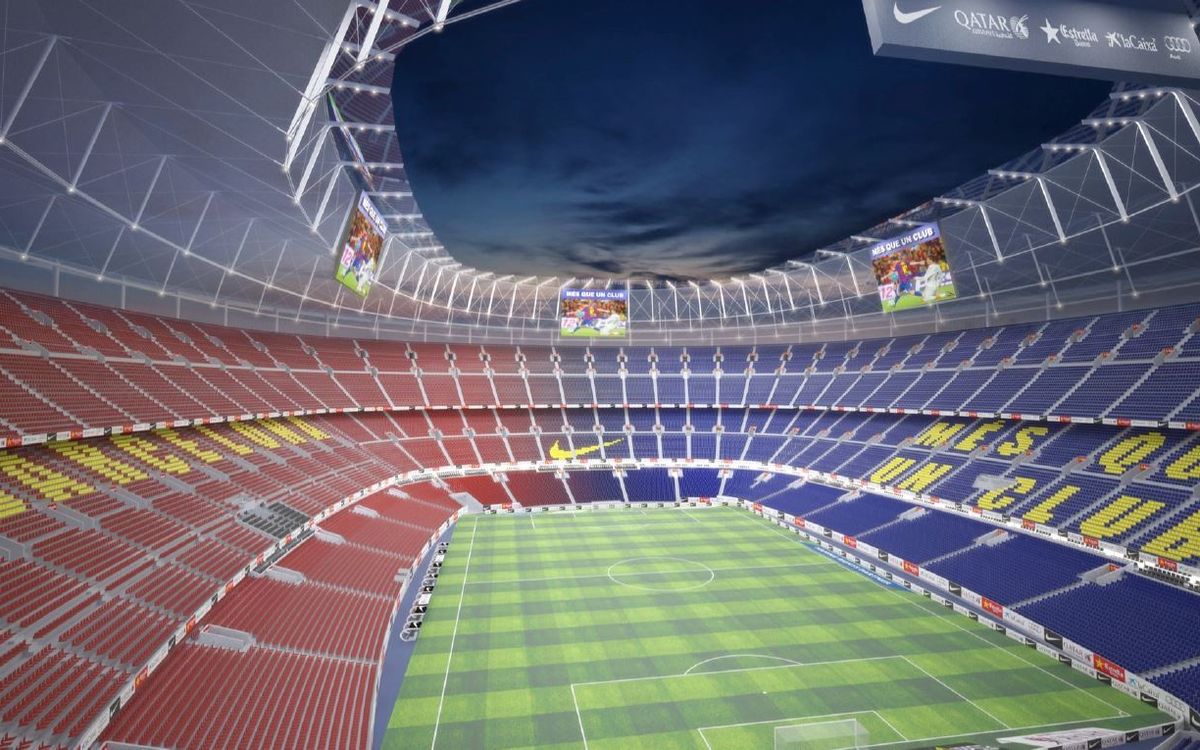A new stadium built on the same structure
- label.aria.viber Viber
- label.aria.whatsapp WhatsApp
- label.aria.twitter Twitter
- label.aria.facebook Facebook
- label.aria.messenger Messenger
- label.aria.link label.aria.tick Copy link
On Monday, the first details have been revealed of what the new Camp Nou would look like. The board has presented a proposal that, according to the studies that have been conducted, will enable a new stadium to be built over the current structure, ultimately creating the same kind of stadium that would have resulted out of starting from zero. The Camp Nou would remain in Les Corts, but would look very different both on the inside and outside.
The proposal includes improved functionality, accessibility, mobility, sustainability, modernity and quality, designed to be at the service of the people, the neighbourhood and the city. This new Camp Nou would include three main areas: the Camp Nou itself, a new Palau Blaugrana for 10,000 spectators and the Espai Barça (Barça Space), which would involve buildings for different purposes integrated into the district.
The restructuring would mean moving the new Miniestadi to the Ciutat Esportiva training ground, which would seat between 6,000 and 7,000 people.
Bigger, more modern and more profitable
The Camp Nou would go from having just short of 100,000 seats as it does now to 105,000. A new, steeper first tier of terracing would vastly improve the sightlines, which are not great in some parts of the current stadium, while the second tier would largely remain the same, with the third tier being expanded. These changes would mean about 10% of the season ticket holders would have to be moved, but always to places with a better view of the field, although the definitive project has yet to be specified.
There will also be a new ring of boxes and restaurants overlooking the pitch, along with what are called ‘superboxes’ and other VIP services between the first and second tiers.. The quality of the VIP services will be vastly improved both in terms of quantity and quality (3,500 new seats would create a total of 5,700 luxury seats).
The stadium walkways and corridors will also be changed. There will be a perimeter ring to make passage between different zones smoother, and will also enable improvements to the range of culinary items on offer, as well as better cleaning services and public conveniences. Escalators and lifts will be used to reach the third tier, and the current structure will be vastly more streamlined, and will receive much more daylight. The new Camp Nou will, in short, have more facilities, better signage and will also be better adapted for disabled users.
The master camera position will also be changed to fit with UEFA requirements, and a second system of electronic advertising hoardings will be included, thus helping to boost club income.
Outside, the Camp Nou will have more parking spaces, making room for a total of 5,000 cars.
Almost four years of work
If the referendum on April 5 or 6 gives the project the go-ahead, then the work on the new Camp Nou would begin in May 2017, depending on the eventual plans and municipal permits, and take almost four years, with much of the work being done during the close-season, finalising in February 2021.
The work would be going on throughout three and a half football seasons. The work on the exterior will largely be done while the stadium is being used for matches, while the work on the terraces will be done in the summer, thus minimising the inconvenience caused to spectators. However, the biggest priority of all during the construction process will, naturally, be safety.
Despite the work, the FC Barcelona first team will be able to continue playing games at the Camp Nou regardless, which has been another priority of the project. So, there will be no major effect on ground capacity.
Today’s announcement comes after a year and a half of studies, an investment that has cost around one million euros. The club has been working with ISG (a company specialising in identifying and optimising new sources of income and improving the spectator experience in new stadiums), AEG (which organises sports and entertainment events), ICON Venue Group (a company specialising in project management, and stadium development around the world) and Ryder Levett Bucknall (a company specialising in the financial control and management of projects).
- label.aria.viber Viber
- label.aria.whatsapp WhatsApp
- label.aria.twitter Twitter
- label.aria.facebook Facebook
- label.aria.messenger Messenger
- label.aria.link label.aria.tick Copy link

